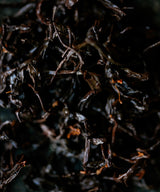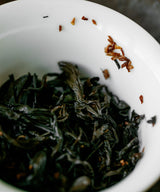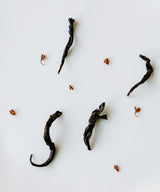Osmanthus Laoshan Black
桂花崂山红茶
Harvest
October 25, 2022
Origin
Qingdao, Shandong
Osmanthus flowers are extremely ephemeral. Their trees bloom once every year, for two weeks in October. In a village nestled within the cliffs of Mount Lao, an area to which the Osmanthus trees are indigenous, this is an unmistakable event. For a short time, the area is filled with the incredibly sweet smell of the flowers. The tiny blossoms fall nearly as soon as they have opened, covering the ground in a tangerine coloured snow. In their descent they fill the air with what appear like dancing fairies, inflected by the wind. There are only three days when these delicate flowers may be harvested and still retain the intensity of their smell. During this time Grandmothers in the village patiently collect them by hand, as they have for generations in Laoshan.
Tea leaves are long known to have the remarkable capacity to absorb and preserve the scent of flowers that would otherwise disappear. However, the process of scenting tea leaves is laborious and long-developed; it began in the Southern Song Dynasty more than 1000 years ago. It requires a careful understanding of the ratio of flower to tea, and several rounds of infusions to achieve a lasting transfer of the flower's otherwise fleeting scent. Mr. Tang’s family, who craft many teas in Laoshan, is known for their skill at carrying this tradition forward.
The many small plots that make up Mr. Tang’s tea farm are scattered along the ocean, at the foot of Mount Lao. Some are distributed right along the beaches, exposed to the wind that blows off of the water, while others are tucked slightly up into the forested hills, protected by the mountain behind them. There is a great peace that settles over this area of Laoshan. The tranquility of Mr. Tang’s tea farm is resounding, and extends between its many parts. Following a path that connects the plots next to the ocean to the ones tucked away in the forest, the sound of the ocean waves progressively gives way to the sound of forest birds and running springs. There is a remarkable variety of trees along this path. The smell of the ocean gives way to red pines, overlayed with the scent of green plum.
To make this tea the leaves are harvested by Mr. Tang’s mother and grandmother and then scented by his uncle. The tea then remains combined with the dried osmanthus flowers. When we prepare this tea, the flowers will dance in water much like they did in the air as they were falling. However, we must keep in mind that, while this tea appears to consist of two distinct things, the osmanthus and the Laoshan black have, through scenting, blended to become one single, indistinguishable flavour. It is their hybridity we taste for.
And this hyrbid is sweet! Like chocolate, orange, Grand Marnier, even Ferrero Rocher. This tea is eerily pleasurable to drink. After several infusions the osmanthus blows off and we are left with the deep warmth of laoshan black.
This tea is like dessert: have it, you deserve it.
. . .
Brewing guide
| Tea | 4g |
| Temperature | 95 °C |
| Water | 120ml |
| Steep time | 10 - 60 sec |
| No. of infusions | 8 |












